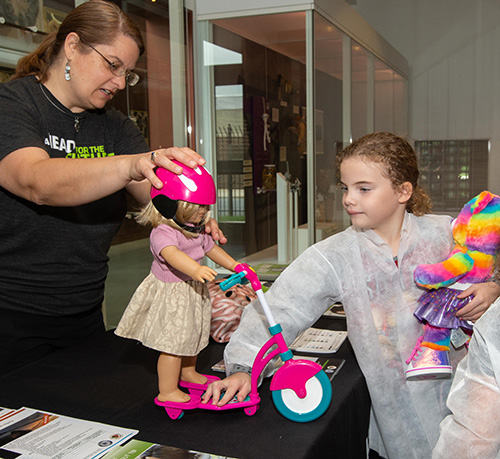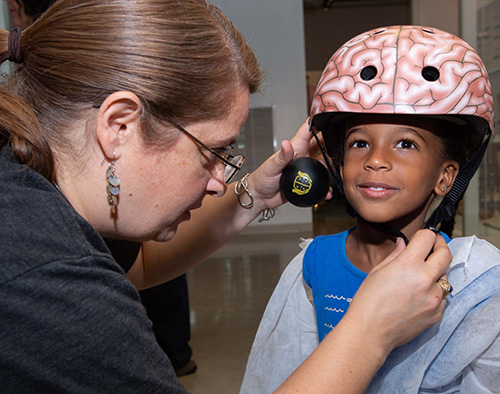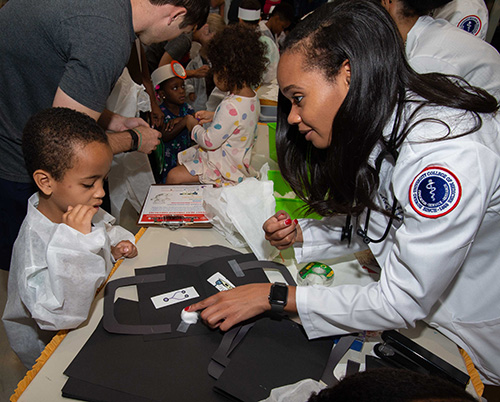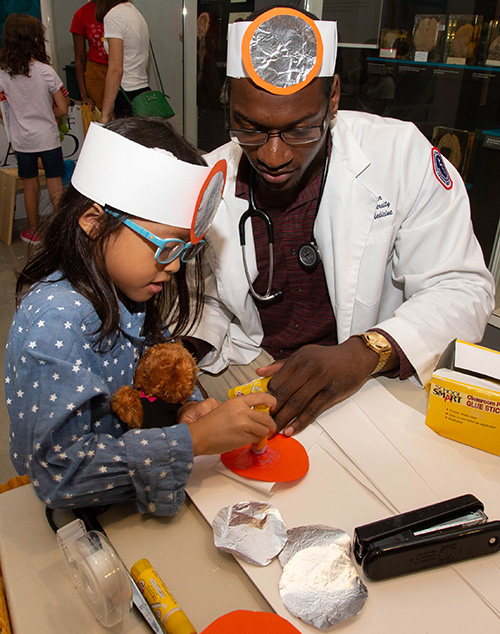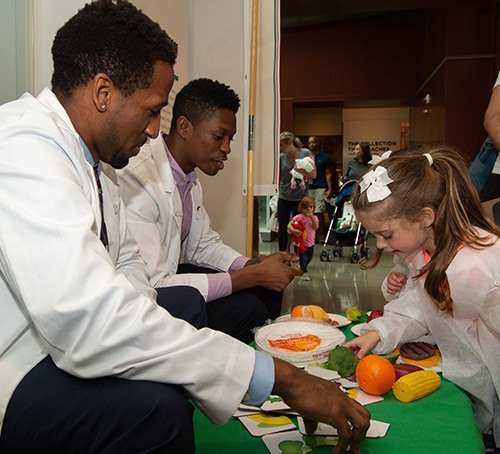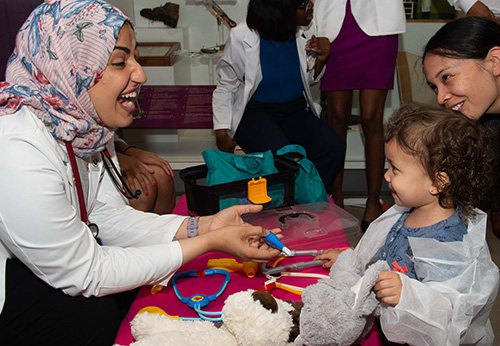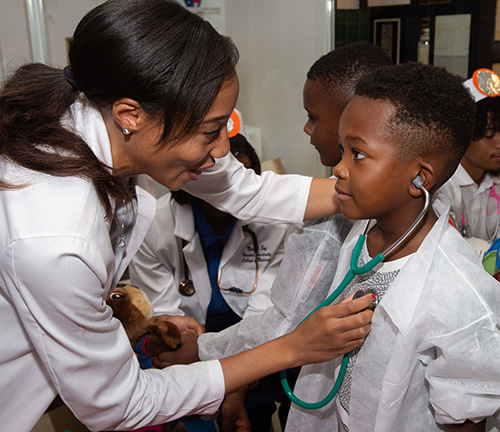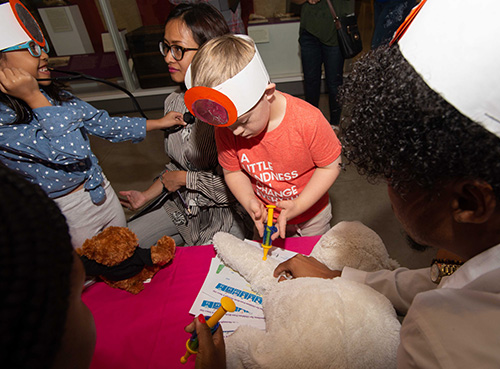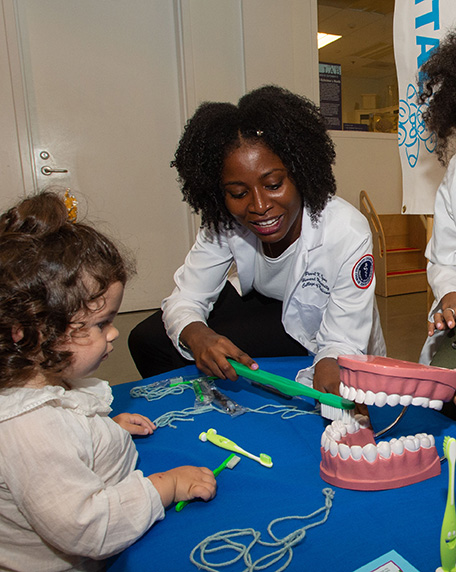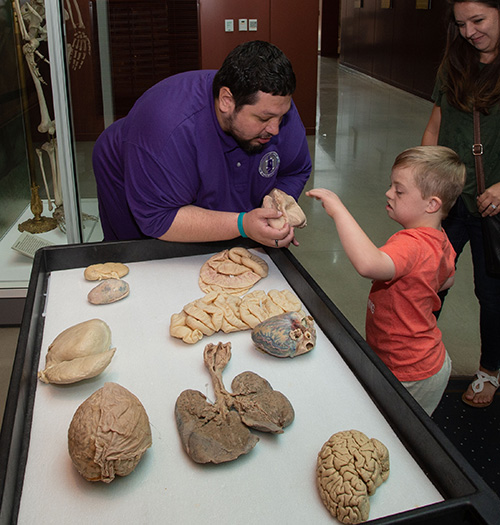Military Medical Museum's Teddy Bear Clinic Made Learning Fun For Children
By Lauren Bigge
NMHM Public Affairs Coordinator

Children visiting Walter Reed National Military Medical Center's audiology table examine a model of an ear and stick a vibrating tuning fork in water to see a wave form, with assistance from Army 1st Lt. Katie Rhea, audiology extern from the HHC Troop Command, as Army 1st Lts. Tia McDonald, Melissa Work and Heather Fischle observe during the Teddy Bear Clinic on Sept. 8, 2018 at the National Museum of Health and Medicine in Silver Spring, Md. (National Museum of Health and Medicine photo by Matthew Breitbart / Released)
Children enjoyed giving their stuffed animal patients "check-ups" as they learned age-appropriate health information during the National Museum of Health and Medicine's (NMHM) Teddy Bear Clinic on Sept. 8. This public program, which has been an annual event at the NMHM since 2009, provides a morning of education for the youngest visitors to the Department of Defense's museum by offering them opportunities to learn about the body, physical fitness, healthy habits, and military medicine.
Through hands-on experiences at different stations, children had fun finding out the basics about vital signs, hearing protection, nutrition, dental health, immunizations, exercise, brain safety, and the importance of sleep. Volunteers working the stations represented the Defense and Veterans Brain Injury Center's (DVBIC) A Head for the Future initiative, Walter Reed National Military Medical Center's audiology clinic, Howard University's Pediatric Interest Association (HUPIA), Howard University's Department of Physical Therapy, and the University of Maryland's Infant and Child Studies Consortium.
The young visitors made doctors' bags, nurses' hats, and head mirrors at the crafts table under the guidance of HUPIA volunteers. "I really want them to understand that coming to the doctor's office isn't a scary experience," said Brendon Martin, vice president of community service for HUPIA. "I want them to feel comfortable knowing that whatever ailment they may have, we're here to help them, and help their families." HUPIA volunteer Danielle Thompson agreed. "We're showing them different objects they might see at the doctor," she said. "The more they see these, the more comfortable they'll be."
HUPIA volunteers worked the nutrition, vitals, immunization and dental tables as well. Children placed food models on a plate at the nutrition table, in response to questions about which items they thought were healthy to eat. At the vitals table, they learned the purpose of doctor's tools such as a stethoscope and a blood pressure cuff. "We're teaching the kids the tools that the doctors are using," explained Miranda Barnes. "For kids who are interested in becoming doctors one day, they're already practicing those skills. We're teaching them to be assertive and to engage. You can see the light in their eyes. They're checking every little detail; as doctors you have to pay attention to every detail of your patients."
Mya Stierwalt of Silver Spring watched her 2-year-old daughter, Grace, move enthusiastically from table to table. "She enjoys it all," Stierwalt said. "We started with the stethoscope and the otoscope [a medical device which is used to look into the ears], and then she got shots for her bunny rabbit. She loves brushing her teeth," Stierwalt added, as Grace brushed the oversized teeth model at the dental table. Volunteers chatted with Grace and other children about when to brush their teeth, reaching all the teeth when they brush, and to floss well.
At the immunization table, some children followed Grace's example in administering shots to their stuffed animals, to protect those friends from diseases. "They know where to administer the shot," HUPIA volunteer Rikiana Brown noted.
Protection was the theme elsewhere as well. Personnel from Walter Reed National Military Medical Center's audiology clinic started out at their table by guiding the children in giving stuffed animals a hearing test. A demonstration with a tuning fork and water followed, to highlight hearing protection. A tuning fork that is struck and then placed in a bowl of water will vibrate, creating a small wave. "We're using the tuning forks to show kids that sound is energy," Army 1st Lt. Heather Fischle said.
Brain protection was also an important lesson of the day. Heidi Lenzini, representing the A Head for the Future initiative, provided information about traumatic brain injury prevention and recovery and showed visitors how to properly wear a bicycle helmet to protect the brain. A Head for the Future, launched by the Defense and Veterans Brain Injury Center, provides resources to help the military community prevent, recognize, and recover from traumatic brain injury. Jada Brown from Howard University's Department of Physical Therapy helped Lenzini by showing children an activity related to traumatic brain injury - wearing goggles that distort the visual field as they attempted an "obstacle course" on a mat. "You can have visual problems if you get any type of traumatic brain injury," Brown explained.
More physical therapy students from Howard interacted with the children just a few steps away. Some young visitors jumped on colorful circles to build up their bone strength, while others got pointers from Felix Skievaski about how to do squats, push-ups, and pull-ups to help increase their strength as they engage in various age-appropriate exercises. "We're here to spread awareness and show them proper techniques so they're not substituting any extra muscle, and to prevent injuries," he said.
Children who visited the University of Maryland's Infant and Child Studies Consortium table colored brain worksheets and worked on cross-word puzzles as they learned basic facts about how important sleep is to health. "We're relating it to the brain," Tolu Adetayo said, pointing out that sleep aids in digestion and helps the body to recover.
"The NMHM's Teddy Bear Clinic promotes wellness and good health practices for our young attendees and their families," said Andrea Schierkolk, the NMHM's public programs manager. "The children learn about STEM (Science, Technology, Engineering and Math) career paths as they practice healthy habits."
The NMHM's public programs connect the mission of the Department of Defense museum with the public. The NMHM was founded as the Army Medical Museum in 1862 and moved to its new location in Silver Spring, MD in 2012. Information on upcoming events can be found at www.medicalmuseum.mil.
